Critical Reading Is Important: Why?

Reading is a proven way to improve knowledge and increase mental abilities. These benefits are enjoyed by those who read for pleasure and those studying in school. It has been shown that those who engage in critical reading have an increase in these benefits.
So, why is critical reading important? It plays a crucial role in your development as a reader and is an excellent workout for the brain. Reading has critical effects on mental development. If you are looking for how to improve critical reading skills, we have an article dedicated to that topic . It offers valuable tips and provides detailed information on why critical thinking is essential to reading.

What Does Reading Critically Mean?
Critical reading refers to the ability to read content and understand the material while determining whether it is fact or fiction. It involves analyzing and evaluating all content. You will have to judge the credibility of what has been written instead of simply assuming it is true. The process involves reading content and then questioning what has been said so you can determine validity. This is an essential skill that will be needed if you are a student who needs to conduct research. It can help in selecting different sources that will be referenced in your own research.
How Is This Important and Effective?
Having the ability to comprehend and understand what is being read is a skill that all students will require. Why is critical viewing, listening, and reading important? It can help enhance the ability to understand and is essential for higher earning. Successful students will not take things at face value. They will use these skills to assess what information is essential and whether it has the appropriate facts.
What is the most crucial requirement for critical reading and writing? This is a question that all students should be able to answer. The main requirement is identifying fact from fiction. You also must be able to look at any arguments presented and determine whether they are supported by valid research.
Beyond mastering the art of critical reading, learning about services like Babbel and the associated Babbel cost could also be beneficial. Babbel offers a wide range of language learning courses, which could help in developing your critical reading skills in multiple languages.
Why Do I Need Critical Reading Skills?
As a reader, having specific skills will help you better understand the text. Instead of simply skimming words, you will benefit from enhanced comprehension. Those who are critical thinkers and readers will seek knowledge. Why is it important to have critical reading skills? As a student, you can raise questions from the content and then be able to evaluate and solve any problems. You will also be able to base all judgments on evidence.
These skills will also help readers identify various arguments and ask thought-provoking questions. This later allows you to develop ideas based on analysis. Instead of simply accepting the information that is presented, having these skills allows for the development of an individualized interpretation of ideas.
As a student applying for college, critical reading will be part of your SAT exam. After completing the exam, you will start the application process for getting into the desired school. One thing that is important at this time is deadlines. Some schools will have a priority deadline. What is a priority deadline ? This is the time in which you must submit an application for consideration.
When it comes to college admissions, there is a difference between rolling admission and standard decisions. If you do not meet the priority deadline, your application will be considered on a rolling basis.
Is rolling admission the same as a regular decision? No. Rolling admission refers to the review of applications as they are sent in. There are no specific deadlines in place. With a regular decision process, you have to submit an application within a specific time frame. We have more detailed information on rolling admissions and priority deadlines on our blog .
Important to Determine Arguments

As a student, critical reading will be important when completing academic assignments. You have to develop your own arguments when writing papers and these skills allow this to be done. By reading texts multiple times, focus can be placed on different aspects. The information that is presented can be analyzed and evidence can be used to support your argument.
When reading, you will have to determine whether the information included can support an argument with facts and data. Why are critical reading skills important? Instead of accepting a claim that is made by another, critical readers will have the skills to examine arguments and see things from both sides. By being able to constantly evaluate what is being read, you can determine if an argument is logical and backed by proper research.
Improving critical reading skills can be an asset for every student. In addition to understanding why critical reading is important, explore strategies on how to improve critical reading . The skills you’ll gain are not only applicable in academic contexts but also invaluable for everyday life.
Critical Reading and Assumptions and Values
When reading any content, it is important to analyze any assumptions that are made by an author. An Assumption is something that an author believes is true in order for them to make an argument. One must have the ability to question any assumptions and determine if it has value. Value is something that one person thinks has importance. Why are values important to known in critical reading? One must understand an argument of an author and use their values to determine whether the standpoint is factual.
Uses in Conducting Scientific Research
When conducting research and completing scientific research papers, this form of thinking will be essential. No matter how technical the subject matter may be, a writer will ace to make a variety of decisions during the research process. This will include determining what information to include in a paper. If you are wondering why is critical reading and thinking important, you will quickly see how effective it is when conducting research.
As you prepare to conduct research, you will have to make use of different sources and the writings of other people. Having appropriate skills will enable one to perform good research and know exactly what to include to make a strong argument. Some features of critical reading that will be used when performing research include:
- Examining evidence or current arguments
- Checking the influence of such evidence
- Learning the limitations of focus
- Examining interpretations
- Deciding how to use researched arguments or opinions
As we delve into the importance of critical reading, considering the safety of online tutoring platforms becomes pertinent. Assessing the question, is online tutoring safe , helps ensure that the learning environment is conducive and secure, adding another layer of confidence as you engage in the learning process.
Critical Thinking and Writing
Critical thinking is a life skill that is learned and it is the ability to understand and evaluate information that is read. Why is reading an important critical thinking skill? The more you read, the more you can analyze information and filter that using your own thought process. This can be a powerful tool in the development of being a critical thinker. As a writer, this skill can help you present ideas and concepts that will stimulate readers.
Critical thinking is what will define your writing style . The best writers are those who have the ability to think critically. If you are wondering why is critical thinking important in reading and writing, it is because it paves the road for a writer to create a story or article that presents an argument clearly. It allows writers to choose appropriate words and ideas that will convey the message with the greatest impact.
Why Ambiguity is Important
Ambiguity plays a key role in being a critical thinker or reader. This refers to words or phrases having various meanings. One must force themselves to look for ambiguity. Any term will be ambiguous when it has a meaning that is uncertain and will require further clarification before any judgment can be made. When making an argument, ambiguity should be avoided. You want clear and concise information that will support a view or an opinion.
If any words or phrases need clarification, they will be considered to be ambiguous. It is essential to take the time to read content and examine it carefully so you can determine the meaning of any phrases. If that meaning is still uncertain, an important ambiguity has been detected. As a student, this will require an extensive vocabulary. You need to know the different meanings of words and determine whether the information supports an argument.
If you need help with improving your critical reading skills, consider hiring an online tutor. We have a list of the top ones here .
The most effective communicators will ensure clarity. They will review what has been written to make sure no cases of ambiguity are present. This allows for a strong argument to be presented and removes any doubt a reader may have.

Writer & Editor
Born and raised with French heritage, our featured author brings a unique European flair to his writing. With years of experience, he has honed his skills as a professional copywriter, mastering not only his native French but also English, ...
Relevant articles

Let’s assume you have registered for this exam and it turns out you don’t feel quite ready to take it. Maybe you wish to postpone it, or don’t take it at all and instead take a different exam. After all, if you are not required by the college to submit your score, then there is…
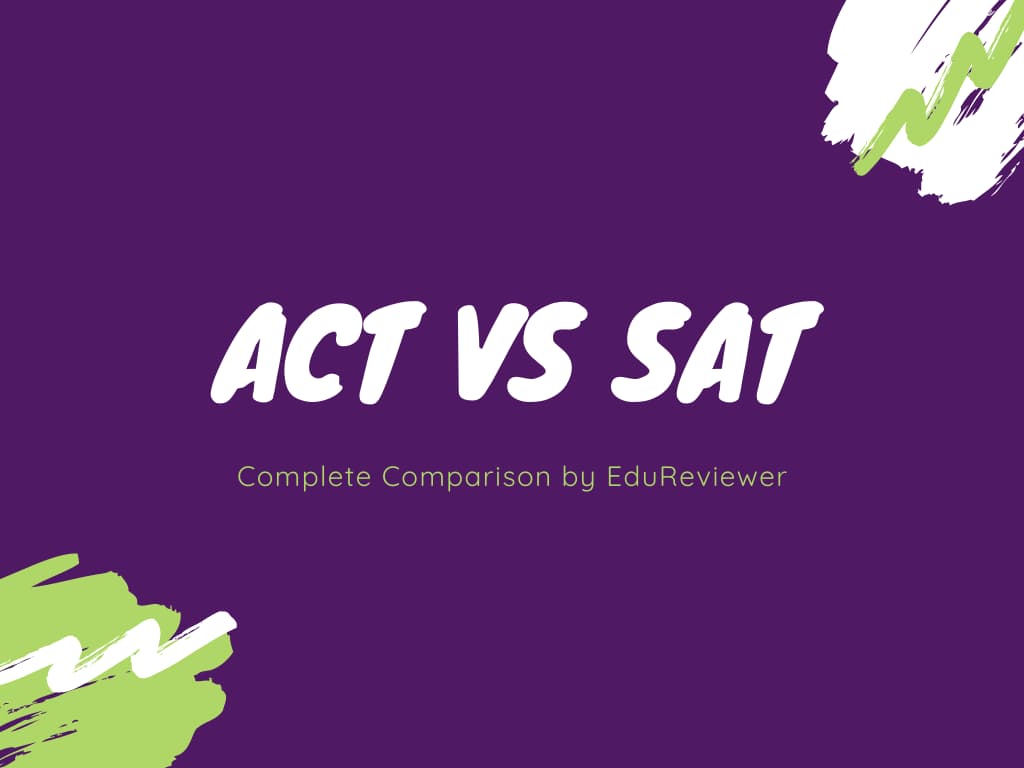
One of the hardest periods a teenager could experience is probably his or her high school life. When you have to start thinking about your future – what course you want to take, where you want to study, and what your career plans would be ten to twenty years from now. But to get into…
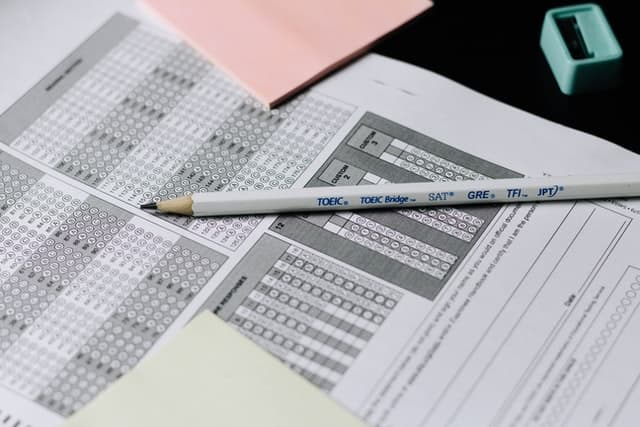
Featured Photo by Nguyen Dang Hoang Nhu on Unsplash “Without continual growth and progress, such words as improvement, achievement, and success have no meaning”, – Benjamin Franklin Knowing how to raise SAT score 200 points in a week can definitely come in handy. At first, it may sound impossible, but with the right strategy and…
Critical reading is a valuable tool for educational growth. It opens our minds better to understand articles and written works such as novels. Critical thinking is essential as it allows us to engage in critical thinking and writing. You need to read with a purpose and value to develop good critical reading skills.
Your email address will not be published. Required fields are marked *
Admission Consulting The Five Best Graduate School Admissions Consultants Reviewed
Resume Writing CompTIA Certification on Resume: How to Put It [+Examples]
Resume Writing Can You Put Udemy On Resume?

OFF on lessons

Critical Thinking: What It Is and Why It Matters
Defining critical thinking dispositions and why they’re crucial..
Posted September 23, 2024 | Reviewed by Devon Frye
- Another way to think about and measure critical thinking is to include aspects of motivational dispositions.
- Dispositions include open-mindedness and a willingness to be reflective when evaluating information.
- People scoring low in critical thinking dispositions tend to “keep it simple” when something is complex.
- Critical thinking dispositions help individuals avoid oversimplification and can facilitate awareness of bias.
Critical thinking springs from the notion of reflective thought proposed by Dewey (1933), who borrowed from the work of philosophers such as William James and Charles Peirce. Reflective thought was defined as the process of suspending judgment, remaining open-minded, maintaining a healthy skepticism, and taking responsibility for one’s own development (Gerber et al., 2005; Stoyanov & Kirshner, 2007).
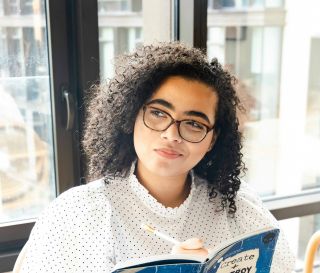
Kurland (1995) suggested, “Critical thinking is concerned with reason, intellectual honesty, and open-mindedness, as opposed to emotionalism, intellectual laziness, and closed-mindedness. Thus, critical thinking involves… considering all possibilities… being precise; considering a variety of possible viewpoints and explanations; weighing the effects of motives and biases; being concerned more with finding the truth than with being right…being aware of one’s own prejudices and biases” (p. 3). Thus, being able to perspective-take and becoming conscious of one’s own biases are potential benefits of critical thinking capacities.
Reviews of the critical thinking literature (e.g., Bensley, 2023) suggest that the assessment of this construct ought to include aspects of motivational dispositions. Numerous frameworks of critical thinking dispositions have been proposed (e.g., Bensley, 2018; Butler & Halpern, 2019; Dwyer, 2017); some commonly identified dispositions are open-mindedness, intellectual engagement, and a proclivity to take a reflective stance or approach to evaluating information and the views and beliefs of both oneself and others. Demir (2022) posited that critical thinking dispositions reflect persons’ attitudes toward and routine ways of responding to new information and diverging ideas, willingness to engage in nuanced and complex rather than either/or reductionistic thinking, and perseverance in attempts to understand and resolve complex problems.
Other examples of dispositions are inquisitiveness, open-mindedness, tolerance for ambiguity, thinking about thinking, honesty in assessing or evaluating biases, and willingness to reconsider one’s own views and ways of doing things (Facione et al., 2001). Individual personality attributes associated with these proclivities include a need for cognition (a desire for intellectual stimulation), which is positively associated with critical thinking, and the need for closure (a motivated cognitive style in which individuals prefer predictability, firm answers, and rapid decision making ) and anti-intellectualism (a resentment of “the life of the mind” and those who represent it), both negatively associated with critical thinking.
Further, an ideological component that can impede critical thinking is dogmatism . In addition, rigid, dichotomous thinking impedes critical thinking in that it oversimplifies the complexity of social life in a pluralistic society (Bensley, 2023; Cheung et al., 2002; Halpern & Dunn, 2021) and tries to reduce complicated phenomena and resolve complex problems via “either/or” formulations and simplistic solutions.
In other words, folks with low critical thinking dispositions would tend to “keep it simple” when something is really quite complicated, and think it absolute terms and categories rather than seeing “the gray” in between the black and white extremes.
In sum, critical thinking dispositions are vitally important because they may help individuals avoid oversimplifying reality; they also permit perspective-taking and can facilitate their awareness of diversity and systematic biases, such as racial or gender bias . Some research has indicated that critical thinking dispositions uniquely contribute to academic performance beyond general cognition (Ren et al., 2020), and may help to reduce unsubstantiated claims and conspiracy beliefs (Bensley, 2023; Lantian et al., 2021).
But before we can study the potential impact of critical thinking dispositions, it is necessary to have a reliable, valid, and hopefully brief measure for this construct. I will discuss the development and validation of a measure of critical thinking dispositions in another post.
Bensley, D.A. ( 2023.) Critical thinking, intelligence, and unsubstantiated beliefs: An integrative review. Journal of Intelligence, 1 , 207. https://doi.org/10.3390/jintelligence11110207
Bensley, D.A. (2018). Critical thinking in psychology and everyday life: A guide to effective thinking . New York: Worth Publishers.
Butler, H.A., & Halpern, D.F. (2019). Is critical thinking a better model of intelligence? In Robert J. Sternberg (Ed.) The Nature of Intelligence (pp. 183–96). Cambridge: Cambridge University Press.
Cheung, C.-K, Rudowicz. E., Kwan, A., & Yue, X.. (2002). Assessing university students’ general and specific criticalthinking. College Student Journal, 36 , 504 – 25.
Demir, E. (2022). An examination of high school students’ critical thinking dispositions and analytical thinking skills. Journal of Pedagogical Research, 6 , 190–200. https://doi.org/10.33902/JPR.202217357
Dewey, J. (1933). How we think: A restatement of the relation of reflective thinking to the educative process . Lexington: Heath and Company.
Dwyer, C. P. (2017). Critical thinking: Conceptual perspectives and practical guidelines . Cambridge: CambridgeUniversity Press.
Facione, P., Facione, N,C,, & Giancarlo, C.A.F. (2001(. California Critical Disposition Inventory . Millbrae: California Academic Press.
Gerber, S., Scott, L., Clements, D.H., & Sarama, J. (2005). Instructor influence on reasoned argument in discussion boards. Educational Technology, Research & Development, 53 , 25–39. https://doi.org/10.1007/BF02504864
Halpern, D. F., & Dunn, D.S. (2021). Critical thinking: A model of intelligence for solving real-world problems. Journal of Intelligence, 9 , 22. https://doi.org/10.3390/jintelligence9020022
Kurland, D. (1995). I know what it says… What does it mean? Critical skills for critical reading . Belmont: Wadsworth.
Lantian, A., Bagneux, V., Delouvee, S., & Gauvrit, N. (2021). Maybe a free thinker but not a critical one: High conspiracybelief is associated with low critical thinking ability. Applied Cognitive Psychology, 35 , 674 – 84. https://doi.org/10.1002/acp.3790
Ren, X., Tong, Y., Peng, P. & Wang, T. (2020). Critical thinking predicts academic performance beyond general cognitiveability: Evidence from adults and children. Intelligence, 82 , 101487. https://doi.org/10.1016/j.intell.2020.101487
Stoyanov, S., & Kirschner, P. ( 2007). Effect of problem solving support and cognitive styles on idea generation:Implications for technology-enhanced learning. Journal of Research on Technology in Education, 40 , 49–63. https://doi.org/10.1080/15391523.2007.10782496

Kyle D. Killian, Ph.D., LMFT is the author of Interracial Couples, Intimacy and Therapy: Crossing Racial Borders.
- Find a Therapist
- Find a Treatment Center
- Find a Psychiatrist
- Find a Support Group
- Find Online Therapy
- United States
- Brooklyn, NY
- Chicago, IL
- Houston, TX
- Los Angeles, CA
- New York, NY
- Portland, OR
- San Diego, CA
- San Francisco, CA
- Seattle, WA
- Washington, DC
- Asperger's
- Bipolar Disorder
- Chronic Pain
- Eating Disorders
- Passive Aggression
- Personality
- Goal Setting
- Positive Psychology
- Stopping Smoking
- Low Sexual Desire
- Relationships
- Child Development
- Self Tests NEW
- Therapy Center
- Diagnosis Dictionary
- Types of Therapy

It’s increasingly common for someone to be diagnosed with a condition such as ADHD or autism as an adult. A diagnosis often brings relief, but it can also come with as many questions as answers.
- Emotional Intelligence
- Gaslighting
- Affective Forecasting
- Neuroscience

- LEARNING SKILLS
- Study Skills
- Critical Reading
Search SkillsYouNeed:
Learning Skills:
- A - Z List of Learning Skills
- What is Learning?
- Learning Approaches
- Learning Styles
- 8 Types of Learning Styles
- Understanding Your Preferences to Aid Learning
- Lifelong Learning
- Decisions to Make Before Applying to University
- Top Tips for Surviving Student Life
- Living Online: Education and Learning
- 8 Ways to Embrace Technology-Based Learning Approaches
- Critical Thinking Skills
- Critical Thinking and Fake News
- Understanding and Addressing Conspiracy Theories
- Critical Analysis
- Top Tips for Study
- Staying Motivated When Studying
- Student Budgeting and Economic Skills
- Getting Organised for Study
- Finding Time to Study
- Sources of Information
- Assessing Internet Information
- Using Apps to Support Study
- What is Theory?
- Styles of Writing
- Effective Reading
- Note-Taking from Reading
- Note-Taking for Verbal Exchanges
- Planning an Essay
- How to Write an Essay
- The Do’s and Don’ts of Essay Writing
- How to Write a Report
- Academic Referencing
- Assignment Finishing Touches
- Reflecting on Marked Work
- 6 Skills You Learn in School That You Use in Real Life
- Top 10 Tips on How to Study While Working
- Exam Skills
Get the SkillsYouNeed Study Skills eBook

Part of the Skills You Need Guide for Students .
- Writing a Dissertation or Thesis
- Research Methods
- Teaching, Coaching, Mentoring and Counselling
- Employability Skills for Graduates
Subscribe to our FREE newsletter and start improving your life in just 5 minutes a day.
You'll get our 5 free 'One Minute Life Skills' and our weekly newsletter.
We'll never share your email address and you can unsubscribe at any time.
Critical Reading and Reading Strategy
What is critical reading.
Reading critically does not, necessarily, mean being critical of what you read.
Both reading and thinking critically don’t mean being ‘ critical ’ about some idea, argument, or piece of writing - claiming that it is somehow faulty or flawed.
Critical reading means engaging in what you read by asking yourself questions such as, ‘ what is the author trying to say? ’ or ‘ what is the main argument being presented? ’
Critical reading involves presenting a reasoned argument that evaluates and analyses what you have read. Being critical, therefore - in an academic sense - means advancing your understanding , not dismissing and therefore closing off learning.
See also: Listening Types to learn about the importance of critical listening skills.
To read critically is to exercise your judgement about what you are reading – that is, not taking anything you read at face value.
When reading academic material you will be faced with the author’s interpretation and opinion. Different authors will, naturally, have different slants. You should always examine what you are reading critically and look for limitations, omissions, inconsistencies, oversights and arguments against what you are reading.
In academic circles, whilst you are a student, you will be expected to understand different viewpoints and make your own judgements based on what you have read.
Critical reading goes further than just being satisfied with what a text says, it also involves reflecting on what the text describes, and analysing what the text actually means, in the context of your studies.
As a critical reader you should reflect on:
- What the text says: after critically reading a piece you should be able to take notes, paraphrasing - in your own words - the key points.
- What the text describes: you should be confident that you have understood the text sufficiently to be able to use your own examples and compare and contrast with other writing on the subject in hand.
- Interpretation of the text: this means that you should be able to fully analyse the text and state a meaning for the text as a whole.
Critical reading means being able to reflect on what a text says, what it describes and what it means by scrutinising the style and structure of the writing, the language used as well as the content.
Critical Thinking is an Extension of Critical Reading
Thinking critically, in the academic sense, involves being open-minded - using judgement and discipline to process what you are learning about without letting your personal bias or opinion detract from the arguments.
Critical thinking involves being rational and aware of your own feelings on the subject – being able to reorganise your thoughts, prior knowledge and understanding to accommodate new ideas or viewpoints.
Critical reading and critical thinking are therefore the very foundations of true learning and personal development.
See our page: Critical Thinking for more.
Developing a Reading Strategy
You will, in formal learning situations, be required to read and critically think about a lot of information from different sources.
It is important therefore, that you not only learn to read critically but also efficiently.
The first step to efficient reading is to become selective.
If you cannot read all of the books on a recommended reading list, you need to find a way of selecting the best texts for you. To start with, you need to know what you are looking for. You can then examine the contents page and/or index of a book or journal to ascertain whether a chapter or article is worth pursuing further.
Once you have selected a suitable piece the next step is to speed-read.
Speed reading is also often referred to as skim-reading or scanning. Once you have identified a relevant piece of text, like a chapter in a book, you should scan the first few sentences of each paragraph to gain an overall impression of subject areas it covers. Scan-reading essentially means that you know what you are looking for, you identify the chapters or sections most relevant to you and ignore the rest.
When you speed-read you are not aiming to gain a full understanding of the arguments or topics raised in the text. It is simply a way of determining what the text is about.
When you find a relevant or interesting section you will need to slow your reading speed dramatically, allowing you to gain a more in-depth understanding of the arguments raised. Even when you slow your reading down it may well be necessary to read passages several times to gain a full understanding.
See also: Speed-Reading for Professionals .
Following SQ3R
SQ3R is a well-known strategy for reading. SQ3R can be applied to a whole range of reading purposes as it is flexible and takes into account the need to change reading speeds.
SQ3R is an acronym and stands for:
This relates to speed-reading, scanning and skimming the text. At this initial stage you will be attempting to gain the general gist of the material in question.
It is important that, before you begin to read, you have a question or set of questions that will guide you - why am I reading this? When you have a purpose to your reading you want to learn and retain certain information. Having questions changes reading from a passive to an active pursuit. Examples of possible questions include:
- What do I already know about this subject?
- How does this chapter relate to the assignment question?
- How can I relate what I read to my own experiences?
Now you will be ready for the main activity of reading. This involves careful consideration of the meaning of what the author is trying to convey and involves being critical as well as active.
Regardless of how interesting an article or chapter is, unless you make a concerted effort to recall what you have just read, you will forget a lot of the important points. Recalling from time to time allows you to focus upon the main points – which in turn aids concentration. Recalling gives you the chance to think about and assimilate what you have just read, keeping you active. A significant element in being active is to write down, in your own words, the key points.
The final step is to review the material that you have recalled in your notes. Did you understand the main principles of the argument? Did you identify all the main points? Are there any gaps? Do not take for granted that you have recalled everything you need correctly – review the text again to make sure and clarify.
Continue to: Effective Reading Critical Thinking
See also: Critical Analysis Writing a Dissertation Critical Thinking and Fake News
- For Individuals
- For Businesses
- For Universities
- For Governments
- Online Degrees
- Join for Free
What Are Critical Thinking Skills and Why Are They Important?
Learn what critical thinking skills are, why they’re important, and how to develop and apply them in your workplace and everyday life.
![what is the importance of critical reading and critical thinking [Featured Image]: Project Manager, approaching and analyzing the latest project with a team member,](https://d3njjcbhbojbot.cloudfront.net/api/utilities/v1/imageproxy/https://images.ctfassets.net/wp1lcwdav1p1/1SOj8kON2XLXVb6u3bmDwN/62a5b68b69ec07b192de34b7ce8fa28a/GettyImages-598260236.jpg?w=1500&h=680&q=60&fit=fill&f=faces&fm=jpg&fl=progressive&auto=format%2Ccompress&dpr=1&w=1000)
We often use critical thinking skills without even realizing it. When you make a decision, such as which cereal to eat for breakfast, you're using critical thinking to determine the best option for you that day.
Critical thinking is like a muscle that can be exercised and built over time. It is a skill that can help propel your career to new heights. You'll be able to solve workplace issues, use trial and error to troubleshoot ideas, and more.
We'll take you through what it is and some examples so you can begin your journey in mastering this skill.
What is critical thinking?
Critical thinking is the ability to interpret, evaluate, and analyze facts and information that are available, to form a judgment or decide if something is right or wrong.
More than just being curious about the world around you, critical thinkers make connections between logical ideas to see the bigger picture. Building your critical thinking skills means being able to advocate your ideas and opinions, present them in a logical fashion, and make decisions for improvement.

Build job-ready skills with a Coursera Plus subscription
- Get access to 7,000+ learning programs from world-class universities and companies, including Google, Yale, Salesforce, and more
- Try different courses and find your best fit at no additional cost
- Earn certificates for learning programs you complete
- A subscription price of $59/month, cancel anytime
Why is critical thinking important?
Critical thinking is useful in many areas of your life, including your career. It makes you a well-rounded individual, one who has looked at all of their options and possible solutions before making a choice.
According to the University of the People in California, having critical thinking skills is important because they are [ 1 ]:
Crucial for the economy
Essential for improving language and presentation skills
Very helpful in promoting creativity
Important for self-reflection
The basis of science and democracy
Critical thinking skills are used every day in a myriad of ways and can be applied to situations such as a CEO approaching a group project or a nurse deciding in which order to treat their patients.
Examples of common critical thinking skills
Critical thinking skills differ from individual to individual and are utilized in various ways. Examples of common critical thinking skills include:
Identification of biases: Identifying biases means knowing there are certain people or things that may have an unfair prejudice or influence on the situation at hand. Pointing out these biases helps to remove them from contention when it comes to solving the problem and allows you to see things from a different perspective.
Research: Researching details and facts allows you to be prepared when presenting your information to people. You’ll know exactly what you’re talking about due to the time you’ve spent with the subject material, and you’ll be well-spoken and know what questions to ask to gain more knowledge. When researching, always use credible sources and factual information.
Open-mindedness: Being open-minded when having a conversation or participating in a group activity is crucial to success. Dismissing someone else’s ideas before you’ve heard them will inhibit you from progressing to a solution, and will often create animosity. If you truly want to solve a problem, you need to be willing to hear everyone’s opinions and ideas if you want them to hear yours.
Analysis: Analyzing your research will lead to you having a better understanding of the things you’ve heard and read. As a true critical thinker, you’ll want to seek out the truth and get to the source of issues. It’s important to avoid taking things at face value and always dig deeper.
Problem-solving: Problem-solving is perhaps the most important skill that critical thinkers can possess. The ability to solve issues and bounce back from conflict is what helps you succeed, be a leader, and effect change. One way to properly solve problems is to first recognize there’s a problem that needs solving. By determining the issue at hand, you can then analyze it and come up with several potential solutions.
How to develop critical thinking skills
You can develop critical thinking skills every day if you approach problems in a logical manner. Here are a few ways you can start your path to improvement:
1. Ask questions.
Be inquisitive about everything. Maintain a neutral perspective and develop a natural curiosity, so you can ask questions that develop your understanding of the situation or task at hand. The more details, facts, and information you have, the better informed you are to make decisions.
2. Practice active listening.
Utilize active listening techniques, which are founded in empathy, to really listen to what the other person is saying. Critical thinking, in part, is the cognitive process of reading the situation: the words coming out of their mouth, their body language, their reactions to your own words. Then, you might paraphrase to clarify what they're saying, so both of you agree you're on the same page.
3. Develop your logic and reasoning.
This is perhaps a more abstract task that requires practice and long-term development. However, think of a schoolteacher assessing the classroom to determine how to energize the lesson. There's options such as playing a game, watching a video, or challenging the students with a reward system. Using logic, you might decide that the reward system will take up too much time and is not an immediate fix. A video is not exactly relevant at this time. So, the teacher decides to play a simple word association game.
Scenarios like this happen every day, so next time, you can be more aware of what will work and what won't. Over time, developing your logic and reasoning will strengthen your critical thinking skills.
Learn tips and tricks on how to become a better critical thinker and problem solver through online courses from notable educational institutions on Coursera. Start with Introduction to Logic and Critical Thinking from Duke University or Mindware: Critical Thinking for the Information Age from the University of Michigan.

Article sources
University of the People, “ Why is Critical Thinking Important?: A Survival Guide , https://www.uopeople.edu/blog/why-is-critical-thinking-important/.” Accessed May 18, 2023.
Keep reading
Coursera staff.
Editorial Team
Coursera’s editorial team is comprised of highly experienced professional editors, writers, and fact...
This content has been made available for informational purposes only. Learners are advised to conduct additional research to ensure that courses and other credentials pursued meet their personal, professional, and financial goals.
Reading & Writing Purposes
Introduction: critical thinking, reading, & writing, critical thinking.
The phrase “critical thinking” is often misunderstood. “Critical” in this case does not mean finding fault with an action or idea. Instead, it refers to the ability to understand an action or idea through reasoning. According to the website SkillsYouNeed [1]:
Critical thinking might be described as the ability to engage in reflective and independent thinking.
In essence, critical thinking requires you to use your ability to reason. It is about being an active learner rather than a passive recipient of information.
Critical thinkers rigorously question ideas and assumptions rather than accepting them at face value. They will always seek to determine whether the ideas, arguments, and findings represent the entire picture and are open to finding that they do not.
Critical thinkers will identify, analyze, and solve problems systematically rather than by intuition or instinct.
Someone with critical thinking skills can:
- Understand the links between ideas.
- Determine the importance and relevance of arguments and ideas.
- Recognize, build, and appraise arguments.
- Identify inconsistencies and errors in reasoning.
- Approach problems in a consistent and systematic way.
- Reflect on the justification of their own assumptions, beliefs and values.
Read more at: https://www.skillsyouneed.com/learn/critical-thinking.html

Critical thinking—the ability to develop your own insights and meaning—is a basic college learning goal. Critical reading and writing strategies foster critical thinking, and critical thinking underlies critical reading and writing.
Critical Reading
Critical reading builds on the basic reading skills expected for college.
College Readers’ Characteristics
- College readers are willing to spend time reflecting on the ideas presented in their reading assignments. They know the time is well-spent to enhance their understanding.
- College readers are able to raise questions while reading. They evaluate and solve problems rather than merely compile a set of facts to be memorized.
- College readers can think logically. They are fact-oriented and can review the facts dispassionately. They base their judgments on ideas and evidence.
- College readers can recognize error in thought and persuasion as well as recognize good arguments.
- College readers are skeptical. They understand that not everything in print is correct. They are diligent in seeking out the truth.
Critical Readers’ Characteristics
- Critical readers are open-minded. They seek alternative views and are open to new ideas that may not necessarily agree with their previous thoughts on a topic. They are willing to reassess their views when new or discordant evidence is introduced and evaluated.
- Critical readers are in touch with their own personal thoughts and ideas about a topic. Excited about learning, they are eager to express their thoughts and opinions.
- Critical readers are able to identify arguments and issues. They are able to ask penetrating and thought-provoking questions to evaluate ideas.
- Critical readers are creative. They see connections between topics and use knowledge from other disciplines to enhance their reading and learning experiences.
- Critical readers develop their own ideas on issues, based on careful analysis and response to others’ ideas.
The video below, although geared toward students studying for the SAT exam (Scholastic Aptitude Test used for many colleges’ admissions), offers a good, quick overview of the concept and practice of critical reading.
Critical Reading & Writing
College reading and writing assignments often ask you to react to, apply, analyze, and synthesize information. In other words, your own informed and reasoned ideas about a subject take on more importance than someone else’s ideas, since the purpose of college reading and writing is to think critically about information.
Critical thinking involves questioning. You ask and answer questions to pursue the “careful and exact evaluation and judgment” that the word “critical” invokes (definition from The American Heritage Dictionary ). The questions simply change depending on your critical purpose. Different critical purposes are detailed in the next pages of this text.
However, here’s a brief preview of the different types of questions you’ll ask and answer in relation to different critical reading and writing purposes.
When you react to a text you ask:
- “What do I think?” and
- “Why do I think this way?”
e.g., If I asked and answered these “reaction” questions about the topic assimilation of immigrants to the U.S. , I might create the following main idea statement, which I could then develop in an essay: I think that assimilation has both positive and negative effects because, while it makes life easier within the dominant culture, it also implies that the original culture is of lesser value.
When you apply text information you ask:
- “How does this information relate to the real world?”
e.g., If I asked and answered this “application” question about the topic assimilation , I might create the following main idea statement, which I could then develop in an essay: During the past ten years, a group of recent emigrants has assimilated into the local culture; the process of their assimilation followed certain specific stages.
When you analyze text information you ask:
- “What is the main idea?”
- “What do I want to ‘test’ in the text to see if the main idea is justified?” (supporting ideas, type of information, language), and
- “What pieces of the text relate to my ‘test?'”
e.g., If I asked and answered these “analysis” questions about the topic immigrants to the United States , I might create the following main idea statement, which I could then develop in an essay: Although Lee (2009) states that “segmented assimilation theory asserts that immigrant groups may assimilate into one of many social sectors available in American society, instead of restricting all immigrant groups to adapting into one uniform host society,” other theorists have shown this not to be the case with recent immigrants in certain geographic areas.
When you synthesize information from many texts you ask:
- “What information is similar and different in these texts?,” and
- “What pieces of information fit together to create or support a main idea?”
e.g., If I asked and answered these “synthesis” questions about the topic immigrants to the U.S. , I might create the following main idea statement, which I could then develop by using examples and information from many text articles as evidence to support my idea: Immigrants who came to the United States during the immigration waves in the early to mid 20th century traditionally learned English as the first step toward assimilation, a process that was supported by educators. Now, both immigrant groups and educators are more focused on cultural pluralism than assimilation, as can be seen in educators’ support of bilingual education. However, although bilingual education heightens the child’s reasoning and ability to learn, it may ultimately hinder the child’s sense of security within the dominant culture if that culture does not value cultural pluralism as a whole.

Critical reading involves asking and answering these types of questions in order to find out how the information “works” as opposed to just accepting and presenting the information that you read in a text. Critical writing involves recording your insights into these questions and offering your own interpretation of a concept or issue, based on the meaning you create from those insights.
- Crtical Thinking, Reading, & Writing. Authored by : Susan Oaks, includes material adapted from TheSkillsYouNeed and Reading 100; attributions below. Project : Introduction to College Reading & Writing. License : CC BY-NC: Attribution-NonCommercial
- Critical Thinking. Provided by : TheSkillsYouNeed. Located at : https://www.skillsyouneed.com/ . License : Public Domain: No Known Copyright . License Terms : Quoted from website: The use of material found at skillsyouneed.com is free provided that copyright is acknowledged and a reference or link is included to the page/s where the information was found. Read more at: https://www.skillsyouneed.com/
- The Reading Process. Authored by : Scottsdale Community College Reading Faculty. Provided by : Maricopa Community College. Located at : https://learn.maricopa.edu/courses/904536/files/32966438?module_item_id=7198326 . Project : Reading 100. License : CC BY: Attribution
- image of person thinking with light bulbs saying -idea- around her head. Authored by : Gerd Altmann. Provided by : Pixabay. Located at : https://pixabay.com/photos/light-bulb-idea-think-education-3704027/ . License : CC0: No Rights Reserved
- video What is Critical Reading? SAT Critical Reading Bootcamp #4. Provided by : Reason Prep. Located at : https://www.youtube.com/watch?v=5Hc3hmwnymw . License : Other . License Terms : YouTube video
- image of man smiling and holding a lightbulb. Authored by : africaniscool. Provided by : Pixabay. Located at : https://pixabay.com/photos/man-african-laughing-idea-319282/ . License : CC0: No Rights Reserved

Privacy Policy
Want to create or adapt books like this? Learn more about how Pressbooks supports open publishing practices.
2 – Critical Reading

“Citizens of modern societies must be good readers to be successful. Reading skills do not guarantee success for anyone, but success is much harder to come by without being a skilled reader. The advent of the computer and the Internet does nothing to change this fact about reading. If anything, electronic communication only increases the need for effective reading skills and strategies as we try to cope with the large quantities of information made available to us.” –William Grabe
The importance of reading as a literacy skill is without a doubt. It is essential for daily life navigation and academic success. Reading for daily life navigation is relatively easier, compared to academic reading. Think about the kinds of reading you did in elementary and high school (e.g., story books, picture books, textbook chapters, literary works, online information, lecture notes, etc.).
Now think about what you were expected to do with your reading at school (e.g., memorize, summarize, discuss, pass a test, apply information, or write essays or papers).
Research shows that what you expect to do with a text affects how you read it.
–Bartholomae & Petrosky (1996)
So, reading is not always the same; you read school texts differently than the texts you choose outside of school tasks. Furthermore, there are many external and internal factors that influence how you interpret and use what you read. Much depends on your background (e.g., cultural participation in communities, identity, historical knowledge), and the context in which you are reading. Classrooms and teachers certainly have an influence. The teaching methods used by your instructor, the texts your instructor chooses, and expectations of student performance on assignments all affect how you read and what you do to accomplish an assignment.
Different levels of education also emphasize different types of reading. For example, in primary or secondary education, you learn what is known, so you focus on correctness, memorization of facts, and application of facts. In higher education, although you might still be required to understand and memorize information, you expand what is known by examining ideas and creating new knowledge. In those processes at different levels, reading has been used for different purposes.
Multilingual reading and writing expert William Grabe has identified six different purposes:
- Reading to search for information (scanning and skimming)
- Reading for quick understanding (skimming)
- Reading to learn
- Reading to integrate information
- Reading to evaluate, critique, and use information
- Reading for general comprehension (in many cases, reading for interest or reading to entertain)
In college, reading to evaluate, critique, and use information is the most practiced and tested skill. But what does it mean? Reading to evaluate, critique, and use information is related to critical reading.
Definition of Critical Reading
Critical reading is a more ACTIVE way of reading. It is a deeper and more complex engagement with a text. Critical reading is a process of analyzing, interpreting and, sometimes, evaluating. When we read critically, we use our critical thinking skills to QUESTION both the text and our own reading of it. Different disciplines may have distinctive modes of critical reading (scientific, philosophical, literary, etc).
[Source: Duncan , n.d., Critical Reading ]
Critical reading does not have to be all negative. The aim of critical reading is not to find fault but to assess the strength of the evidence and the argument. It is just as useful to conclude that a study, or an article, presents very strong evidence and a well-reasoned argument, as it is to identify the studies or articles that are weak.
[Source: What is critical reading? ]
There’s No Reason to Eat Animals by Lindsay Rajt
If we care about the environment and believe that kindness is a virtue-as we all say that we do–a vegan diet is the only sensible option. The question becomes: Why eat animals at all?
Animals are made of flesh, bone, and blood, just as you and I are. They form friendships, feel pain and joy, grieve for lost loved ones and are afraid to die. One cannot profess to care about animals while tearing them away from their friends and families and cutting their throats–or paying someone else to do it–simply to satisfy a fleeting taste for flesh.
[adapted from Pattison, 2015, Critical Reading: English for Academic Purposes for instructional purposes ]
What is your position on the issue?
Do you think that the language used helps the audience? How?
How does the language use affect your evaluation of the issue?
Obesity: A Public Health Failure? By Tavis Glassman PhD, MPH, MCHES, Jennifer Glassman M.A., CCC-SLP, and Aaron J. Diehr, M.A.
Obesity rates continue to increase, bringing into question the efficacy of prevention and treatment efforts. While intuitively appealing, the law on weight gain focusing on calories is too simplistic because calories represent only one factor on issues of weight management. From a historical perspective, the recommendation to eat a low fat, high carbohydrate diet may have been the wrong message to promote, thereby making the obesity situation worse. Suggestions to solve the issues of obesity include taxing, restricting advertising, and reducing the use of sugar. Communities must employ these and other strategies to decrease sugar use and reduce obesity rates.
How would you describe the authors’ educational background?
How does the authors’ background affect your evaluation of the argument?
Students Want More Mobile Devices in Classroom by Ellis Booker
Released last week, the Student Mobile Device Survey reveals that students almost unanimously believe mobile technology will change education and make learning more fun. The survey, which collected the responses of 2,350 US students, was conducted for learning company Pearson by Harris Interactive.
According to the survey, 92% of elementary, middle and high school students believe mobile devices will change the way students learn in the future and make learning more fun (90%). A majority (69%) would like to use mobile devices more in the classroom.
The survey results also contained some surprises. For example, college students in math and science are much more likely to use technology for learning, and researchers expected to see this same pattern in the lower grades.
Are you convinced by the survey results? Why?
Color Scheme Associations in Context
The colors you surround yourself with at work are also important as they make a difference in how you are perceived by members of the public. Traditional workplaces still use dark colors such as navy blue, forest green, and chocolate brown to give clients a sense of seriousness and professionalism.
Think about it: which accountant would you choose to prepare your tax return: the one whose office has navy blue drapes and lamps and a maritime scene on the wall or the one whose office is painted in hot pink with a cartoon character on the wall? An online survey of lawyers carried out by Legal Scene magazine showed that of 287 respondents, 38 percent chose a navy blue color scheme for their office; 32 percent chose brown; 19 percent chose forest green; 7 percent chose burgundy; and only 4 percent chose red, pink or orange (Perkins, 2013).
What kind of bias might be implicated in this survey?
What is your personal experience?
These practices do not ask you to memorize or summarize the information you read, but instead, they ask you to provide your opinions and judgment. To answer those questions, you need to engage in critical reading, a form of active reading.
Active reading, which predominates college-level reading, means reading with the purpose of getting a deeper understanding of the texts you are reading and being engaged in the actions of analyzing, questioning, and evaluating the texts. In other words, instead of accepting the information given to you, you challenge its value by examining the source of the information and the formation of an argument.
The difference in how you read falls into two broad categories:
(Source: Reading Critically ]
Reading critically and actively is essential for college students. But what does critical reading look like in actual practice? Here are the steps that you can follow to do the critical reading.
Step 1: Understand the purpose of your reading and be selective
As college students, you are very busy with your daily coursework. A freshman usually takes four to five courses or even six courses per semester. This means you have tons of reading to do every week. Getting to know the purpose of the reading assignments can save you time as your reading is more targeted. Remember you do not have to read a whole chapter or book. What you can do is through scanning to determine the sections that are useful for you and then read the parts carefully.
Step 2: Evaluate the reading text
While reading a text, you need to question/analyze/evaluate the text by considering the following:
- Assess whether a source is reliable (Read around the text for the title, author, publisher, publication date, good/bad examples, tones, etc.)
- Distinguish between facts and opinions (Scan for any evidence)
- Recognize multiple opinions in a text
- Infer meaning when it is not directly stated
- Agree or disagree with what you read
- Consider the relevance of the text to your task
- Consider what is missing from a text
It may well be necessary to read passages several times to gain a full understanding of texts and be able to evaluate the source. In this process, you can underline, highlight, or circle important parts and points, take notes, or add comments in the margins.
Critical reading often involves re-reading a text multiple times, putting our focus on different aspects of the text. The first time we read a text, we may be focused on getting an overall sense of the information the author is presenting – in other words, simply understanding what they are trying to say. On subsequent readings, however, we can focus on how the author presents that information, the kinds of evidence they provide to support their arguments (and how convincing we find that evidence), the connection between their evidence and their conclusions, etc.
[Source: Lane, 2021, Critical Thinking for Critical Writing ]
Step 3: Document your reading and form your own argument
After you finish reading a text, sort out your notes and keep track of the sources you have read on the topic you are exploring. After you read several sources, you might be able to form your own argument(s) and use the sources as evidence for your argument(s).
In college, critical reading usually leads to critical writing.
Critical writing comes from critical reading. Whenever you have to write a paper, you have to reflect on various written texts, think and interpret research that has previously been carried out on your subject. With the aim of writing your independent analysis of the subject, you have to critically read sources and use them suitably to formulate your argument. The interpretations and conclusions you derive from the literature you read are the stepping stones towards devising your own approach.
[Source: Does Critical Reading Influence Academic Writing? ]
In a word, through critical reading, you form your own argument(s), and the evidence used to support your argument(s) is usually from the texts that you read critically. The Source Essay Writing Service explains how critical reading influences academic writing.
How does critical reading influence your writing skills?
Once you start reading texts critically, you develop an understanding of how to write research papers. Here are some practical tips that will help you in academic writing:
- Examine introductions and conclusions of the texts while critical reading so when you write an independent content, you would be able to decide how to focus your critical work.
- When you highlight or take notes from a text, make sure you focus on the argument. The way the author explains the analytical progress, the concepts used, and arriving at conclusions will help you to write your own facts and examples in an interesting way.
- By closely reading the texts, you will be able to look for the patterns that give meaning, purpose, and consistency to the text. The way the arguments are presented in paragraphs will aid you in structuring information in your writing.
- When you critically read a text, you are able to learn how an argument is placed in the text. Try to understand how you can use this placement strategy in academic writing. Paying attention to the context is an important aspect that you learn from critical reading.
- While reading a text, you will notice that the author has given the due credit to the sources used or the references that were consulted. This will help you in understanding how you can cite sources and quotes in your content.
- Critical reading skills enhance your way of thinking and writing skills. The more you read, the better is your knowledge and vocabulary. It is important to use the precise words to express your meaning. You can learn new words and improve your writing by reading as many texts as you can.
Activity 1: Discuss the following questions with your group
- A website from the United Nations Educational, Scientific ad Cultural Organization (UNESCO) gives some statistics about the level of education reached by young women in Indonesia. Is this a reliable source?
- You find an interesting article about addiction to online gambling. The article has some interesting statistics, but it was published ten years ago. Is it worth using?
- You find a book about World War II that presents a different opinion from your other sources. What would you like to know about the author before you decide whether or not to take him seriously?
- An article tells you that research into space exploration is a waste of money. Do you think this article is presenting facts or opinions? How can you tell? What might you look for in the article?
- You find some research that states that people who own dogs generally live longer lives than those who do not. The author has some convincing arguments, but you are not sure whether or not she has enough evidence. How mush is enough?
- A newspaper article tells you about human rights abuses in a certain country. The writer of this article has never visited the country in question; his claims are based on interviews with other people. How would you evaluate his information?
- You find two websites about the use of seaweed as a source of energy. One is full of long words and complicated sentences; the other uses simple, clear language. Is the first one a more reliable source?
- You have read nine different articles that tell you that there is no connection between wealth and happiness. The tenth article gives the opposite opinion: rich people are happier than those who are poor. What questions would you ask yourself about this article before you decide whether or not to consider it?
Activity 2: Reading for analyzing styles
Please read the news and discuss the importance of the graphs in supporting the arguments of the text.
Gender Pay Gap in U.S. Held Steady in 2020
By amanda barroso and anna brown.
The gender gap in pay has remained relatively stable in the United States over the past 15 years or so. In 2020, women earned 84% of what men earned, according to a Pew Research Center analysis of median hourly earnings of both full- and part-time workers. Based on this estimate, it would take an extra 42 days of work for women to earn what men did in 2020.
As has been the case in recent decades, the 2020 wage gap was smaller for workers ages 25 to 34 than for all workers 16 and older. Women ages 25 to 34 earned 93 cents for every dollar a man in the same age group earned on average. In 1980, women ages 25 to 34 earned 33 cents less than their male counterparts, compared with 7 cents in 2020. The estimated 16-cent gender pay gap among all workers in 2020 was down from 36 cents in 1980.
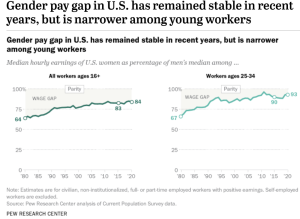
The U.S. Census Bureau has also analyzed the gender pay gap, though its analysis looks only at full-time workers (as opposed to full- and part-time workers). In 2019, full-time, year-round working women earned 82% of what their male counterparts earned, according to the Census Bureau’s most recent analysis.
Why does a gender pay gap still persist?
Much of this gap has been explained by measurable factors such as educational attainment, occupational segregation and work experience. The narrowing of the gap is attributable in large part to gains women have made in each of these dimensions.
Even though women have increased their presence in higher-paying jobs traditionally dominated by men, such as professional and managerial positions, women as a whole continue to be over-represented in lower-paying occupations relative to their share of the workforce. This may contribute to gender differences in pay.
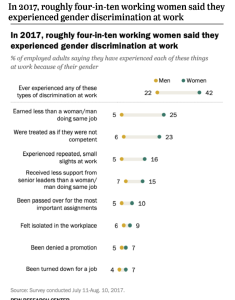
Other factors that are difficult to measure, including gender discrimination, may also contribute to the ongoing wage discrepancy. In a 2017 Pew Research Center survey , about four-in-ten working women (42%) said they had experienced gender discrimination at work, compared with about two-in-ten men (22%). One of the most commonly reported forms of discrimination focused on earnings inequality. One-in-four employed women said they had earned less than a man who was doing the same job; just 5% of men said they had earned less than a woman doing the same job.
Motherhood can also lead to interruptions in women’s career paths and have an impact on long-term earnings. Our 2016 survey of workers who had taken parental, family or medical leave in the two years prior to the survey found that mothers typically take more time off than fathers after birth or adoption. The median length of leave among mothers after the birth or adoption of their child was 11 weeks, compared with one week for fathers. About half (47%) of mothers who took time off from work in the two years after birth or adoption took off 12 weeks or more.
Mothers were also nearly twice as likely as fathers to say taking time off had a negative impact on their job or career. Among those who took leave from work in the two years following the birth or adoption of their child, 25% of women said this had a negative impact at work, compared with 13% of men.
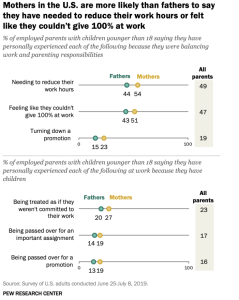
[Source: https://www.pewresearch.org/fact-tank/2021/05/25/gender-pay-gap-facts/ ]
Activity 3: Reading for arguments
What’s the main argument of the poem?
Fire and Ice
By robert frost, some say the world will end in fire, some say in ice. from what i’ve tasted of desire i hold with those who favor fire. but if it had to perish twice, i think i know enough of hate to say that for destruction ice is also great and would suffice..
References:
Barroso, A., & Brown, A. (2021, May 25). Gender pay gap in U.S. held steady in 2020. Pew Research Center. Retrieved July 22, 2022, from https://www.pewresearch.org/fact-tank/2021/05/25/gender-pay-gap-facts/
Bartholomae, D., Petrosky, T., & Waite, S. (2002). Ways of reading: An anthology for writers (p. 720). Bedford/St. Martin’s.
Duncan, J. (n.d.). The Writing Centre, University of Toronto Scarborough. Modified by Michael O’Connor. https://www.stetson.edu/other/writing-program/media/CRITICAL%20READING.pdf
Grabe, W. (2008). Reading in a second language: Moving from theory to practice. Cambridge University Press.
Lane, J. (2021, July 9). Critical thinking for critical writing. Simon Fraser University. Retrieved July 22, 2022, from https://www.lib.sfu.ca/about/branches-depts/slc/writing/argumentation/critical-thinking-writing
Pattison, T. (2015). Critical Reading: English for academic purposes for instructional purposes. Pearson.
Sourceessay. (n.d.). What is critical reading. https://sourceessay.com/does-critical-reading-influence-academic-writing/
University of Leicester. (n.d.). What is critical reading? Bangor University. https://www.bangor.ac.uk/studyskills/study-guides/critical-reading.php.en
Critical Reading, Writing, and Thinking Copyright © 2022 by Zhenjie Weng, Josh Burlile, Karen Macbeth is licensed under a Creative Commons Attribution 4.0 International License , except where otherwise noted.
Share This Book

IMAGES
VIDEO
COMMENTS
If you are wondering why is critical thinking important in reading and writing, it is because it paves the road for a writer to create a story or article that presents an argument clearly. It allows writers to choose appropriate words and ideas that will convey the message with the greatest impact.
In sum, critical thinking dispositions are vitally important because they may help individuals avoid oversimplifying reality; they also permit perspective-taking and can facilitate their...
Critical reading means engaging in what you read by asking yourself questions such as, ‘what is the author trying to say?’ or ‘what is the main argument being presented?’ Critical reading involves presenting a reasoned argument that evaluates and analyses what you have read.
Learn what critical thinking skills are, why they’re important, and how to develop and apply them in your workplace and everyday life. We often use critical thinking skills without even realizing it.
Critical thinking—the ability to develop your own insights and meaning—is a basic college learning goal. Critical reading and writing strategies foster critical thinking, and critical thinking underlies critical reading and writing.
Critical reading is a more ACTIVE way of reading. It is a deeper and more complex engagement with a text. Critical reading is a process of analyzing, interpreting and, sometimes, evaluating. When we read critically, we use our critical thinking skills to QUESTION both the text and our own reading of it.